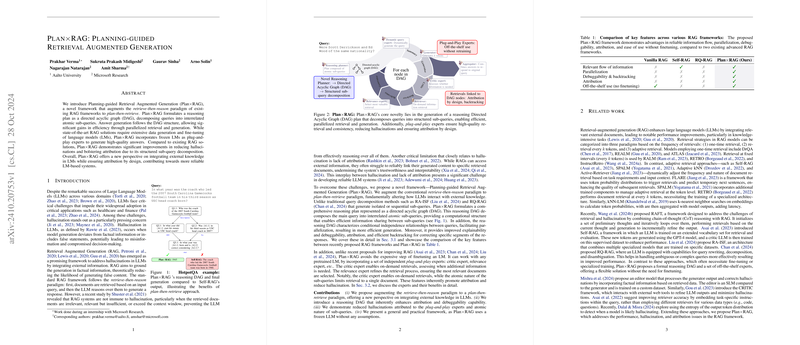PlanRAG: Enhancing Retrieval-Augmented Generation with Planning
The paper "PlanRAG: Planning-guided Retrieval Augmented Generation" presents a new framework for retrieval-augmented generation (RAG) in LLMs. It addresses the limitations of traditional RAG frameworks by reconfiguring the retrieve-then-reason paradigm into a plan-then-retrieve method. This novel architecture introduces multiple innovative elements that enhance efficiency, accuracy, and attribution in generated responses.
Key Characteristics and Methodology
The authors propose a reasoning plan that is formulated in the form of a directed acyclic graph (DAG). This structure decomposes complex queries into interrelated atomic sub-queries, which allows for efficient, parallelized retrieval and generation. Unlike other RAG systems that require model fine-tuning, PlanRAG utilizes frozen LMs coupled with plug-and-play experts, allowing for adaptable and efficient knowledge integration without the need for extensive training iterations.
A significant element of this framework is its method of dynamically generating specific sub-queries based on the query's decomposition. Each sub-query, structured within the DAG, is driven by the responses of parent queries, ensuring that complexity and context are managed efficiently. This addresses common RAG pitfalls such as hallucinations and lack of attribution, as the model retrieves only necessary information and maintains a clear linkage between responses and retrieved documents.
Numerical Results and Performance
In quantitative evaluations, PlanRAG demonstrates marked improvements over existing RAG solutions, particularly in scenarios requiring complex, multi-hop reasoning. The paper provides compelling evidence of reduced hallucinations and enhanced attribution accuracy. The system's modular design, with frozen LMs and independent experts, ensures that retrieval and generation can be effectively customized based on task-specific demands without sacrificing performance.
Theoretical and Practical Implications
The conceptual shift from retrieve-then-reason to plan-then-retrieve represents a rethinking of how LLMs can be aligned with external knowledge systems. The structured decomposition of queries not only improves generation accuracy but also simplifies the debugging and error correction processes. This is due to the individual analysis of sub-query paths in the DAG, which contributes to the explainability of RAG systems.
The practical implications of PlanRAG are broad, particularly in domains where accurate information retrieval is critical, such as healthcare and finance. By ensuring information flow relevance and facilitating efficient resource utilization, this framework can be integrated into applications requiring real-time, trustworthy AI responses.
Future Developments
The trajectory for future research could focus on expanding the expert plug-ins to further augment capabilities, including enhancements for domain-specific reasoning and early-exit mechanisms within DAGs for more efficient processing. Moreover, the paper outlines potential extensions to leverage this architecture's full capacity in dynamic and heterogeneous information environments.
Overall, PlanRAG proposes a significant advancement in retrieval-augmented frameworks, claiming better integration between generative models and external databases through structured planning. This approach presents an adaptable and reliable framework that could steer the development of future LLM applications in knowledge-intensive domains.
